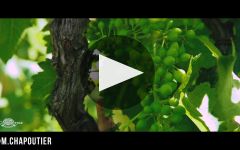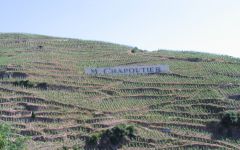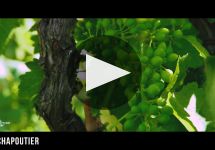M. Chapoutier Ermitage l'Ermite Blanc 2017
-
Robert
Parker -
Jeb
Dunnuck -
Wine
Spectator - Decanter



Product Details
Your Rating
Somm Note
Winemaker Notes
Brilliant pale yellow. Complex aromas of vanilla, almonds, dried fruits and linden-tree. The mineraliaty is marked (typical of soil). Very round and rich wine. An elegant balance, of very ripe white fruit aromas (peach and apricot) and light notes of minerality. Beautiful length and complexity.
Professional Ratings
-
Robert Parker's Wine Advocate
As in 2016, my favorite of the white parcel selections this year is the 2017 Ermitage l'Ermite Blanc (231 cases produced), as it perfectly balances richness and power with refinement and structure. Toasted brioche and citrus marmalade, honey and truffle notes deliver sheer full-bodied, mouth-filling decadence, supported by austere notes of crushed granite, zesty grapefruit rind and cooling brine. Huge and intense yet refreshing, it's the essence of granite-grown Marsanne.
-
Jeb Dunnuck
Lastly, the 2017 Ermitage L’Ermite Blanc is another vibrant white that has an exotic, fresh, focused style in its citrus, lime, honeysuckle, lemon curd, and turmeric/celery seed aromas and flavors. Possessing fabulous extract and concentrated and well as both freshness and purity, it needs 2-3 years of bottle age and should keep for two decades or more. All three of these top whites show a dramatically more reductive, backward style that’s going to benefit from cellaring.
Rating: 98+ -
Wine Spectator
Intense, with a wave of green fig, yellow apple, yellow plum and quince fruit laid atop honeysuckle, acacia and quinine notes that ripple underneath. Shows lovely interplay between rich fruit and racy, streamlined minerality in the end. Best from 2023 through 2040.
-
Decanter
This wine includes some fruit from pre-phylloxera vines planted in 1860. Michel explains that the soils on this lieu-dit are granilite - granite with a touch of calcium; a rare kind of alkaline granite. The wine spends nine months in demi-muid, one-third new. It has distinct notes of almond, linden and iris, with a certain mineral register to the aromatic profile. It's fairly full-bodied and very intense, with an electric palate expression - this is noticeably more acidic than his other white Hermitages this year. It's so vibrant, with less oiliness on the palate compared to the other 2017s - it almost fizzes with minerality.
Other Vintages
2016-
Jeb
Dunnuck -
Robert
Parker
-
Robert
Parker
-
Robert
Parker -
Wine
Spectator
-
Robert
Parker -
Wine
Spectator -
James
Suckling
-
Robert
Parker -
Wine
Spectator
-
Robert
Parker -
Wine
Spectator








No name is more closely associated with the greatness of the Rhone valley than Chapoutier.
The history of the Chapoutier family stretches back to the early nineteenth century when current owner Michel Chapoutier's great-, great-, great-grandfather Marius purchased an estate and some vineyards in the now famous village of Tain l'Hermitage in the Northern Rhône Valley. Marius Chapoutier made history in the region when he became the first grape grower there to vinify his own fruit. Marius had tasted wines other winemakers produced using his fruit and he realized that something was lost in translation, so to speak. He knew that he owned some of the best growing sites in the appellation and he believed — rightly — that the grapes grown in his vineyards could produce long-lived world-class wines. In a move unusual at the time, he decided that he should make the wine himself. Not only did the quality of the wines increase greatly, but this move provided the capital to expand the Chapoutiers’ already legendary estate.
A visionary and pioneer in biodynamic winemaking, his restless energy and unconditional commitment to quality have produced tremendous success, with the most 90+ point ratings of all Rhône producers and 16 "100 point" rated wines.
Sothis Gin is distilled from grapes and plants grown near the vineyards. This family domaine is cultivated using biodynamic practices in which plants play a central role. In their wild state they offer M. Chapoutier a better understanding of the soils. When used in vine treatments they help to nourish plant life and support plant growth. They have selected a few of these plants in order to offer a new perspective of their terroirs, the story of a gin originating from the Tain l’Hermitage vineyards and their floral heritage. They have been honing this recipe for many months under the watchful eye of Sothis, the star and also the ancient Goddess who teaches us that cultivating the land is a means of moving closer to the stars.

One of the star whites of the Rhône Valley and ubiquitous throughout southern France, historically vignerons have favored Marsanne for its hardy and productive vines. It can make a fruity and delicious single varietal wine as well as a serious, full-bodied version with amazing aging potential. The best examples of Marsanne come from the northern Rhone appellations where it is also blended with Roussanne. Sommelier Secret—Some of the oldest Marsanne vines in the entire world exist not in France but in Australia, in the Victoria region. Settlers planted it in the mid to late 1800s, calling it “white Hermitage.”

One of the smallest and most important Syrah regions of northern Rhone, Hermitage is practically one single south-facing slope of crushed granite, thinly covered with varied, yet well-charted soil types. Many climats (well identified parcels) exist within Hermitage and while some smaller producers make single climat Syrahs, some larger ones blend to make one balanced expression of the appellation.
Though the AC regulations allow the addition of up to 15% white grapes to a red Hermitage, in practice it is usually made from Syrah alone. Winemaking is pretty traditional—or you might say historic—with hot fermentations and aging in older barrels of various sizes. The best wines, characterized by deep, dense and sexy flavors of black fruit, cocoa, licorice and tobacco, have massive textures and a solid 10-20 years aging potential.
The region of Hermitage is totally enclosed; the only place it could go really is to literally fall down its own hill into the city of Tain or the Rhone River. Soil erosion is a problem and terraces exist alongside the hill in order to keep the earth in place. Crozes-Hermitage encloses the region entirely to its north and south.
While Hermitage seems synonymous with some of the best Syrah on the planet, actually about one third of the wine produced here comes from white grapes. The full, lush and robust Marsanne or the less common, but almost more charming, Roussanne create wonderful whites in which the best have great potential for aging, like the reds.
